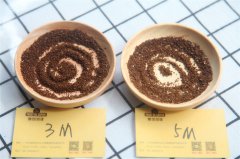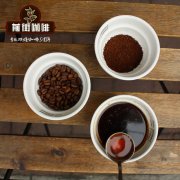The difference of roasting degree of Coffee beans and the characteristics of Coffee Bean roaster Design

Professional coffee knowledge exchange more coffee bean information please follow the coffee workshop (Wechat official account cafe_style)
* the lightest roasted coffee beans are generally called cinnamon roasting degree. The highest temperature of the bean heart is no more than 205 degrees Celsius (the same below). According to the caramelization degree of SCAA, it is "# 95". At this time, the color of the coffee bean is very light brown, the back usually has a strong acidity like acetic acid, the aroma is weak, and the taste is inclined to the taste of cereals. The surface of coffee beans is dry and oil-free.
* shallow roasting, which is slightly deeper than the previous stage, is called New England roasting. The highest temperature of the bean heart is about 205C, which is "# 85" according to the caramelization degree of SCAA. At this time, the acidity in the coffee bean cup is very strong. At the same time, the flavor uniqueness of the coffee bean itself (usually accompanied by the change of acidity) will emerge, and at this time there will be a more obvious sense of viscosity. But it is inferior to the viscosity performance of deep baking. The surface of the coffee bean is still dry and oil-free, but the flavor oil has quietly developed inside the coffee bean.
* deeper, medium-light brown roasting with chromaticity, known as light baking, is within the range of American baking. The highest temperature of bean heart is between 205 and 215 degrees Murray, and the caramelization degree of SCAA is between "# 75" and "# 65". The acidity is bright, but it is no longer too strong, and the flavor uniqueness of coffee beans is still retained, and the consistency is fuller. In the eyes of traditional East Coast coffee drinkers, coffee beans in this roasting mode are the "best coffee".
* the former is slightly darker, medium brown baking with a chromaticity, which is called medium baking, medium-high baking, or urban baking, which is also within the range of American baking. The highest temperature of the bean heart is between 215 and 225 degrees, and the caramelization degree of SCAA is "# 55". The acidity is still obvious, but the flavor is more rich, and the flavor uniqueness of the coffee bean itself is gradually weakened and the consistency is fuller. This is the traditional universal baking model in the western United States.
* the deeper baking depth is called "deep city baking". The highest temperature of the bean heart is between 225Mel 230 degrees. In terms of the caramelization degree of SCAA, it is between "# 55" and "# 45". The acidity weakens slightly and the viscosity becomes thicker. At this baking depth, the unique flavor of coffee beans is almost imperceptible except for the acidity and texture of Kenyan coffee beans such as red wine. Some of the more delicate features, such as the elusive smoky flavor of some coffee beans from Guatemala, are easily lost by roasting.
At this baking depth, a new flavor begins to emerge, which is a special flavor that can only be found in deep-roasted coffee beans. There is no special term in the general evaluation vocabulary, but the author has a name for this flavor. It's called "bitter sweet taste". There is a sugar taste in coffee beans that begins to develop, giving coffee beans at this baking depth a delicate sweetness, which is not quite the same as the sweetness of granulated sugar, but closer to the texture of caramel. at the same time, the performance of acidity is transformed into the expression of irritating flavor, a combination of these flavors that deep roasting lovers are familiar with.
At this time, the bean table may still be dry, or it may begin to appear sporadic oil spots, which are just about to emerge from the inside of the coffee beans. The depth of roasting is the most popular in the northwestern United States (Seattle) and Northern California, and coffee beans are currently available in Starbucks cafes across the United States.
* to the degree of ordinary deep baking, which is called Esspresso baking, European baking, or high baking, the highest temperature of the bean heart is between 230 and 235 degrees, and the caramelization degree of SCAA is between "# 45" and "# 35". At this time, the acidity has been completely wrapped up by the strong feeling, and the flavor uniqueness of the coffee bean itself can no longer be distinguished, and the consistency is full. The bitter taste of deep-roasted coffee beans is also getting stronger and longer. At this baking depth, there must be oil on the surface of coffee beans, from sporadic oil spots to the extent of a thin film.
* when coffee beans are roasted to a very deep roasting degree, such as French roasting, Italian roasting, deep roasting, etc., the highest temperature of the bean heart is between 235 and 240 degrees, and in terms of the caramelization degree of SCAA, it is "# 35". Bitter or deep-roasted coffee beans occupy the whole picture, and the consistency gradually weakens, and the acidity and the unique flavor of coffee beans have been overshadowed by the strong bitter taste. The performance of acidity ranges from round and soft (coffee beans with lower acidity) to the tipping point of bitterness (coffee beans with higher acidity). At this roasting depth of coffee beans, the bean table is always shiny.
* at the stage of very deep baking, there are names such as semantic baking, deep French baking, Spanish baking or re-baking. The highest temperature of bean heart is between 240 and 245 degrees, and the degree of caramelization of SCAA is between "# 35" and "# 25". The viscosity is getting weaker and weaker, while the oil on the bean surface begins to be evaporated at high temperature. at this baking depth, hard work shows a critical point of moderate bitterness. The performance of the cup also began to show a hint of scorching taste, acidity and the unique flavor of the coffee bean itself is not to mention, has long been turned into a part of the deep-roasted flavor level, the bean surface oil is bright, the flavor oil has also been urged out of the bean table.
In addition to the thin consistency and the deep-roasted taste of the dominant flavor, this kind of and deep-roasted coffee beans are very exciting and enjoyable for those who prefer this way. Coffee beans made into lattes with milk or other coffee drinks mixed with milk are very suitable.
* finally, the stage of very deep baking, the appearance of coffee beans is almost black, probably only deep French roasting and Spanish roasting will roast coffee beans to this extent, the highest temperature of bean heart is between 245Mustang 250 degrees, according to the caramelization degree of SCAA, it is "# 25", and deep-roasted coffee beans must be very special taste, with thinner viscosity and bitter sweet taste characteristic of deep-roasted beans. Its bitterness becomes higher, but it is reduced by comparison, and the whole cup of coffee is full of charred and charcoal taste. No matter where the coffee beans come from, once they are roasted to a very deep stage, the flavor is almost exactly the same. The bean surface grease is bright and smooth. Deep-roasted coffee beans like this are not used for brewing espresso. Espresso beans are deep-roasted coffee beans, yes, but not completely blackened, and still have a good consistency and sweetness.
* beyond the previous stage of baking, it is already coke, not coffee beans. There is no sign of consistency at all. it tastes like charred rubber soaking water, and even the fat on the bean table has been dried. Beans like this are not worth boiling at all.
Coffee bean roasting degree intimate suggestion
Coffee should be tasted in the mood of open, because you must get rid of the preconceived ideas, the two main taste judgments of "sour" and "bitter". If you have had an unpleasant taste experience in the past, it is easy to misunderstand and distort the true meaning of these two words. For example, if acid is combined with sweet aroma, the sour taste will become very beautiful, for example: the combination of bitter and sweet. It is as mellow as chocolate, so it is not "sour" or "bitter" is not good, it depends on the combination with what smell, so when drinking coffee, we must first abandon the preconceived concept, so we can taste more coffee with different flavors in the producing areas. Only in this way can you drink your own good coffee.
Important Notice :
前街咖啡 FrontStreet Coffee has moved to new addredd:
FrontStreet Coffee Address: 315,Donghua East Road,GuangZhou
Tel:020 38364473
- Prev

A brief discussion on the difference of roasting degree of coffee beans is Starbucks Italian roasted coffee beans considered deep-roasted?
Professional coffee knowledge exchange more coffee bean information Please follow the coffee workshop (Wechat official account cafe_style) the third wave of coffee aesthetic development, people are increasingly paying attention to the so-called black coffee flavor. Starting from the single bean of the manor and the high-quality beans with few yields, we talk about the producing areas, the flavor characteristics, and even the differences in cooking techniques, utensils, and the degree of baking.
- Next

How about organic coffee powder? how to drink organic coffee? how to drink healthy organic coffee powder? how to cook organic coffee powder?
Professional coffee knowledge exchange more coffee bean information please follow the coffee workshop (Wechat official account cafe_style) this packet of Malongo La Tierra pure Arabica coffee beans is a French Malongo company's excellent flavor beans, it is FR-BIO-01 certified organic coffee powder, and has the French Ministry of Agriculture standard organic agriculture label, but also belongs to
Related
- Beginners will see the "Coffee pull flower" guide!
- What is the difference between ice blog purified milk and ordinary milk coffee?
- Why is the Philippines the largest producer of crops in Liberia?
- For coffee extraction, should the fine powder be retained?
- How does extracted espresso fill pressed powder? How much strength does it take to press the powder?
- How to make jasmine cold extract coffee? Is the jasmine + latte good?
- Will this little toy really make the coffee taste better? How does Lily Drip affect coffee extraction?
- Will the action of slapping the filter cup also affect coffee extraction?
- What's the difference between powder-to-water ratio and powder-to-liquid ratio?
- What is the Ethiopian local species? What does it have to do with Heirloom native species?

